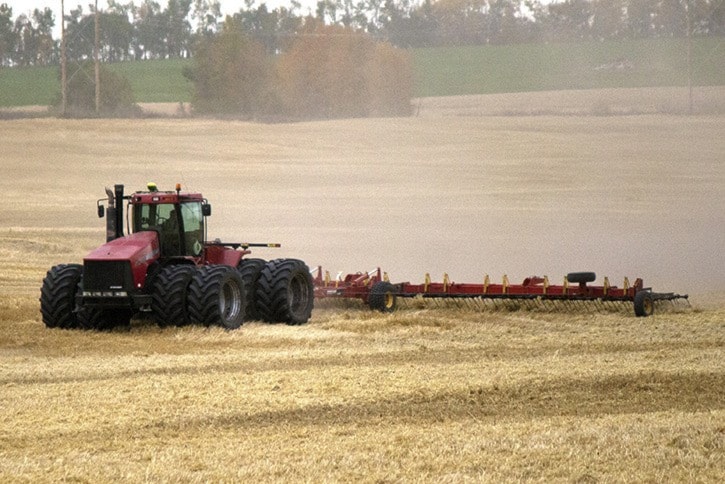A growing season that started off dry and then bogged down under merciless rains, hail and snow has softened crop markets in Canada – though the early snow fall has brought a silver lining with it.
With strong growing seasons in many parts of the globe, Canada's crop prices were "typically dropping or weak," according to Neil Blue, a provincial crop market specialist.
However, with roughly 60 per cent of the crop still in the fields when snow hit Alberta and Saskatchewan, the realization among buyers that lower quality crop yields would be the normal this year has stabilized markets, stopping the downwards slide and, in some cases, helping in recovery of prices.
"There's been some steadying in barley, and sharp rises in canola futures," Blue said. "It doesn't winter very well, and suppliers are a bit concerned."
The canola market was hit hard earlier this year by the rally of bean oil and palm oil prices, which lessens the demand for vegetable oil. With canola making up a large portion of vegetable oils on the market, canola's price is "strongly influenced" by the vegetable oil markets, Blue explained.
Increased calls for vegetable oil out of India has helped bolster vegetable oil prices, as has a dry year in Indonesia and Malaysia, which limits competing oil markets.
"Canola has a way to go to reach its highs, but the prices are better than they've been in weeks," Blue confirmed.
A strong indicator of demand is the "basis level," the distance between the current price offered by crop buyers and the futures price. The greater the margin, the lower the basis level, Blue explained. While there has been spikes here and there among some buyers, who are buying to meet contracted levels of canola, the current low basis level in canola indicates that there is a decent stockpile of quality canola in the hands of suppliers, lowering the demand for lower qualities of canola.
A record-setting yield of soy beans in the United States has had a "suppressing effect" on canola markets, Blue added, though it's not as bad as it could be since canola and soy beans usually do not compete for the same markets. Canola seed is highly sought for vegetable oils rather than canola meal, and soy beans are sought after for soy meal, rather than oils.
With so much soy harvested, though, soy has moved into the oil market as sellers look for a way to liquidate the bumper crop.
Wheat hampered by Russia, Ukraine yieldsWheat harvests in Europe and Eurasia stiffened the competition for grain sales this year, hitting Canada's bread basket hard with lower prices.
The rainy weather and early snow almost guaranteed a lower-than-usual yield quantity and quality, which in turn depressed the animal feed market. Lower-quality grain often ends up being sold for feed rather than human consumption, Blue explained.
The price for quality wheat is still lower than usual, but it has firmed up and even increased after Europe was hit by snow.
"It really affected the grain haul in Europe," Blue explained. "France especially."
Farmers who were fortunate enough to harvest some or all of their wheat crop before the snow fell find themselves in a better place than those who did not, though the abundance of wheat, as well as the stockpile from previous years, has kept the price lower than usual, he said.
Parts of Saskatchewan were hit by a fusarium infection in many crops, which strongly affects wheat prices as the grain cannot be sold for human consumption. It has to be limited in feed to a certain percentage to avoid illness in livestock. The damp weather has been the perfect breeding ground for disease, though it has limited insects, Blue said.
Some grains are doing better than others, Blue said. There is demand for quality malting barley and oats, which is pushing the price for these grains up on the market.
"Shop around to get the best prices," Blue suggested. "Sometimes even downgraded products can have an unexpected market."
Weather wreaks havoc on harvestFarmers are praying for snow to melt even as they knock the dust and rust off grain dryers that have gone unused for years, even decades.
With snow on the fields, and excess moisture levels ensuring machinery will get stuck in fields, farmers are helpless to harvest the crops that lie swathed, standing or lodged on their fields.
"I know some people are talking about a good hard freeze so they can harvest their crops," Blue said, explaining that the frozen crops would then be dried.
"I even heard of one person drying canola, though that has to be done with caution," he said, explaining that the canola pods – which are primarily harvested for oil – are flammable.
He said he'd prefer a good "Indian Summer," where the snow melted off and sunny skies and warm temperatures dried out the ground enough for farmers to harvest the crop. In lieu of that, waiting for the ground to freeze up, a mid-winter harvest, or a spring harvest remain the only option for farmers with crops in the field.
Even before the snow hit, farmers were reeling from excessively wet fields and serious rainstorms that brought with it a decent amount of hail, Blue confirmed.
"Hail losses are higher this year," he said. "Farmers with crop insurance will have some peace of mind."
